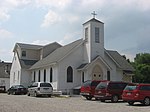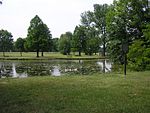Park DuValle, Louisville
Neighborhoods in Louisville, KentuckyNew Urbanism communitiesPopulated places in Kentucky established by African AmericansPublic housing in the United States
Park DuValle is a neighborhood southwest of downtown Louisville, Kentucky. It was developed starting in the late-19th century and historically been a predominantly African-American community. Its boundaries are I-264 (the Shawnee Expressway) to the west, the Norfolk Southern Railway tracks to the north, Cypress Street to the east, and Bells Lane and Algonquin Parkway to the south. The neighborhood reflects the presence of several nearby parks, and DuValle Junior High School; all named after Lucie DuValle, the first female principal of a high school in Louisville.
Excerpt from the Wikipedia article Park DuValle, Louisville (License: CC BY-SA 3.0, Authors).Park DuValle, Louisville
Dr William G Weathers Drive, Louisville
Geographical coordinates (GPS) Address Nearby Places Show on map
Geographical coordinates (GPS)
| Latitude | Longitude |
|---|---|
| N 38.228333333333 ° | E -85.811111111111 ° |
Address
Dr William G Weathers Drive 3311
40211 Louisville
Kentucky, United States
Open on Google Maps





